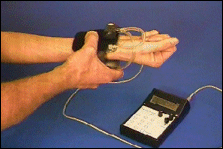Rigidity Analyzer
Several new treatments of Parkinson's disease (PD) are being tested in centers around the world. Outcome assessment in PD has been problematic as it has relied on the qualitative clinical rating of symptoms such as bradykinesia, tremor, and rigidity. We have now developed a system that quantifies one of the key diagnostic variables, rigidity.

Over the years, several engineering approaches to quantifying rigidity have been developed. Typically, large electromechanical devices were used to impose arm movements on PD patients. From our own experience the physical constraints of these techniques lead to estimates of limb mechanical impedance that are poorly correlated with the ratings of clinicians subsequently examining the same patients. In common with other groups recently 1,2 we therefore opted to measure the force and displacement imposed in a normal clinical exam. The novel features of our approach are:
- Use of a differential myometer cuff that registers the resultant force applied to an extremity while ignoring the forces of the clinician's grip.
- Parameter identification to quantify elastic and viscous stiffness.
- Comparisons of the quantified stiffness with clinical ratings.
Related Files:
PROCHAZKA A et al. MEASUREMENT OF RIGIDITY IN PARKINSON'S DISEASE
PATRICK, S.K. et al. QUANTIFICATION OF THE UPDRS RIGIDITY SCALE (2001) IEEE Trans Neural Systems Rehab Eng, 9, 31-41.
Movies:
None available at the moment